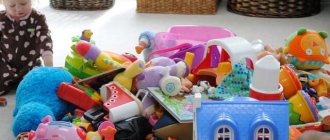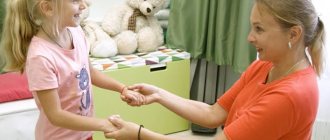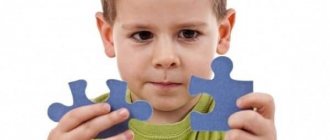Structure and types of leading activities
There are three signs by which a leading activity can be determined:
- leading activity contributes to the emergence of new actions for the child, which he masters over time;
- thanks to it, the formation and restructuring of individual functions of the psyche of a growing person occurs;
- Visible personality changes depend on it.
The mental development of a child is determined by the appropriate type of leading activity. A change in its types means a transition from one stage of development to another, more advanced one.
The stages of human mental development from infancy to senior preschool age are characterized by a certain triune structure of leading activity:
- persisting – moved from the previous stage;
- immediate – characteristic of the current stage;
- nascent - one that is just beginning to develop and will be the leader at the next stage.
Developmental psychology identifies the following types of leading activities at different stages:
- direct emotional communication between the child and the adults around him (from 0 to 1 year);
- object-manipulative (from one to 3 years);
- play (from 3 to 7 years).
For younger schoolchildren (6-11 years old), educational activities are a priority, and for adolescents 11-15 years old, communication is the priority.
Let us take a closer look at the most significant age period for further human development, from 0 to 7 years.
Leading activity from 0 to 1 year
The beginning of a newborn's life is characterized by the fact that he is completely dependent on the mother or the person replacing her. In the full sense of its significance, the leading type of activity from 0 to 2 months has not yet been determined. Starting from the second period (from 2 to 12 months), for the baby this becomes direct emotional communication with the closest person - the mother. It allows the formation of new formations in the psyche that were not previously inherent in the baby:
- separation of sensations and emotional states;
- involuntary attention (the child is capable of short-term fixation on certain objects);
- the beginnings of visual and effective thinking;
- perception of objects;
- autonomous speech.
The leading activities of infancy form the central, most important new formation that determines the transition to the next stage of development - an ever-increasing need for communication with surrounding adults.
What can your child do?
By the age of 5, the baby already has skills, based on which you can judge the normal development of your child, as well as organize his future activities, educational games and activities.
Consider the general development indicators of older preschoolers.
Speech development
- Builds complex sentences and uses verbs in various tense forms.
- He is interested in the meaning of words, tries to explain the meaning of a word on his own, and can come up with it.
- Rhymes words. Sometimes he distorts a word to make it rhyme (for example, grandfather - handsome grandfather).
- Uses intonation.
- Teaches poems, even large ones.
Social and emotional development
- Partially knows how to control his emotions.
- Can manipulate adults through emotions. He understands that if he cries, they will give him candy. In this case, you should not indulge the child.
- Interested in feelings and emotions: “What is love? Why am I angry? Why is the girl screaming?
- Tries to independently cope with difficulties in communication (for example, if someone offended or took away a toy).
- Uses role-playing games and substitute toys.
- Gender identification becomes more pronounced: “I am a boy. Boys are strong and girls are beautiful!”
- In boys, the role of a protector is manifested (to fight, fight, protect mother), and in girls, the role of a mother is manifested (taking care of toys, playing mother-daughter).
Development of thinking and cognitive skills
- Can count to 10 or 20.
- Knows the names of some letters or shows interest in learning them, can even read syllables.
- State your first and last name, age and address.
- Knows the colors and different shapes of objects.
- Orients itself in space: back, forward, left, right, further, closer, higher, lower.
- Can use gadgets (make phone calls, play cartoons on TV/tablet).
- Becomes more independent in maintaining personal hygiene.
- Able to solve simple logical problems.
- Knows the names of surrounding objects.
- Copies or strives to copy the behavior of an adult of the same sex: “I fish like dad!”, “I paint my lips and comb my hair like mom!”.
Gaming and everyday skills
- Plays with the ball (catch, throw).
- Can jump over obstacles.
- Climbing the horizontal bar ladder.
- Makes the bed.
- Cuts with scissors.
- Strives to depict objects (house, person, sun, car).
- Shows interest in sports, dancing or music.
- Knows that crossing the road or playing on the road is dangerous.
Physical development
- The growth process is activated (in a year a child can grow by 10 cm). Boys' height is on average 106-116 cm, and their weight is from 16 to 20 kg. Girls' height is from 102 to 112 cm, weight is from 15 to 19 kg.
- Coordination of movements improves.
- Motor skills are actively developing, thanks to which the child can already perform more complex actions. It should be noted that the ossification process at this age is not yet complete, so bones easily break when falling.
Leading early childhood activities
In infancy, leading activities formed the psychological properties of the child, which allowed him to move to a higher level of development. Now, object-manipulative actions become decisive, through which children learn about the world around them, filled with many different objects. This whole process takes place under the close attention of adults.
The peculiarity of early age lies in a certain separation of the lines of development of the psyche of boys and girls. For boys, object-tool activities become quite important, and for girls, communicative activities. This occurs due to the specifics of communication with them: cultural patterns of relationships in society orient boys and girls to different types of activities. Therefore, the former have more developed abstract thinking, while the latter have more developed social thinking.
Leading activity at an early age forms the following psychological new formations in children of both sexes:
- self-esteem;
- visual-effective thinking;
- recognition with reproduction;
- development of active speech;
- formation of involuntary attention;
- formation of the self-concept (I am myself).
The child requires more trust and a significant amount of independence.
Game is the leading activity in preschool age
At the stage of preschool childhood, development occurs in a situation of learning about human relationships under the influence of an ever-increasing need to imitate them. Therefore, play activity becomes the leading activity for children aged 3-7 years. By the end of the age period, it forms very important new formations in the psyche of a preschooler:
- correct speech;
- involuntary memory;
- analyzing perception;
- visual-figurative thinking;
- creative imagination;
- rudiments of voluntary memory;
- verbal thinking;
- emotional regulation of behavior.
All of them are extremely important for the further development of a full-fledged human personality. Such a large number of neoplasms appear in the process of successive changes in types of gaming activities over 4 years.
Play for a child is a way to express life experiences. In this way, he tries to enter the alluring world of adults, building his model of social relations based on imitation of the existing one. In the process of developing a child’s personality, play goes through several stages of evolution with him.
Subject game
During early childhood, object-based play is important. It is not the leading activity, but is very important for the development of the child. The baby is actively trying to try out familiar objects in new conditions. He is equally enthusiastic about spoon-feeding everyone: his mother, his car, his horse, his doll. And the spoon can be an ordinary popsicle stick. After five minutes, it will become a comb, or a thermometer for the patient. Any jar can turn into a boat or a tea cup. As a result, everyone pretends to drink tea from this cup, where they stir the same imaginary sugar in imaginary water with an imaginary stick-spoon. This is how, through objective play, the little one learns the logic of actions.
The game is plot-display
By the age of three, the child has accumulated enough experience and impressions in understanding the surrounding material world, as well as the world of human relationships. The leading activity in preschool age at this stage is plot-display play. The child plays independently with the toys he has. They are transformed into the main characters of the play invented by the little director.
Habitual dolls become mothers or children, doctors or patients. The child is still unable to distinguish the relationship between them: it is not the toy mother who feeds her son, but the baby puppeteer himself who does this for both of them. But the toddler already clearly indicates the peculiarities of human behavior in reality: his toys are capricious, angry, asking for forgiveness. That is, the game now has a plot and reflects the relationships between people.
How often do moms and dads have the opportunity to recognize themselves by looking at the behavior of a doll controlled by their daughter or son!
Role-playing game
For the older preschooler, the time has come for the most difficult type of leading activity in childhood - role-playing play. Its peculiarity and at the same time complexity: several children already become participants. They not only represent relationships in the game's plot, but also learn them in reality. It happens that a conflict arises from a game, so the children have to learn to distribute and change roles, help each other, share, and prove that they are right. At this stage, leading activities in preschool age shape a person’s business qualities, because one must be able to come to an agreement with others, give in or insist on one’s own.
The borderline age of preschool childhood is approaching ever closer, role-playing games are becoming more and more abstracted from the environment: children, using their imagination, go into space, save people on a desert island, put out fires, etc. They have to establish stricter rules, requiring detailed and precise implementation.
Constantly becoming more complex types of play require the presence and attention of adults who will have to supervise it. No, mentoring instructions should not be given out under any circumstances.
The main role of the father, mother, and educator is to provide food for the imagination of children.
Question 33. Role-playing game, its developmental significance.
A game -
a type of unproductive activity, the motive of which lies not in its results, but in the process itself.
The game is of great importance for the education and development of personality. For children, play, which is commonly called a “childhood companion,” constitutes the main content of life, acts as a leading activity, and is closely intertwined with work and learning.
All aspects of the personality are involved in the game: the child moves, speaks, perceives, thinks; During the game, all his mental processes are actively working: thinking, imagination, memory, emotional and volitional manifestations are intensified. Play acts as an important means of education
Role-playing game -
This is the main type of game for a preschool child. What is its peculiarity? Describing it, S. Ya. Rubinstein emphasized that this game is the most spontaneous manifestation of the child and at the same time it is based on the interaction of the child with adults. It has the main features of the game: emotional richness and enthusiasm of children, independence, activity, creativity.
The main source that feeds a child’s role-playing play is the world around him, the life and activities of adults and peers.
The main feature of a role-playing game is the presence of an imaginary situation in it. The imaginary situation consists of a plot and roles.
Game plot
is a series of events that are united by vitally motivated connections. The plot reveals the content of the game - the nature of the actions and relationships between the participants in the events.
The boy plays The role is the main core of the plot-role-playing game. Most often, the child takes on the role of an adult. Having a role in the game means that in his mind the child identifies himself with this or that person and acts in the game on his behalf. The child uses certain objects appropriately (prepares dinner like a cook; gives an injection like a nurse), enters into various relationships with other players (praises or scolds his daughter, examines a patient, etc.). The role is expressed in actions, speech, facial expressions, pantomime.
In the plot, children use two types of actions: operational and figurative - “as if.” Along with toys, various things are included in the game, and they are given an imaginary, playful meaning.
In a role-playing game, children enter into real organizational relationships (agree on the plot of the game, distribute roles, etc.). At the same time, complex role relationships are simultaneously established between them (for example, mother and daughter, captain and sailor, doctor and patient, etc.).
A distinctive feature of an imaginary play situation is that the child begins to act in a mental, rather than visible, situation: the action is determined by a thought, not a thing. However, the thought in the game still needs support, so often one thing is replaced by another (a stick replaces a spoon), which allows you to carry out the action required by meaning.
The most common motive for role-playing games is the child’s desire for a joint social life with adults. This desire collides, on the one hand, with the child’s unpreparedness for its implementation, and on the other, with the growing independence of children. This contradiction is resolved in a role-playing game: in it, a child, taking on the role of an adult, can reproduce his life, activities and relationships.
The originality of the content of a role-playing game is also one of its most important features. Numerous studies by domestic teachers and psychologists (D. B. Elkonin, D. V. Mendzheritskaya, A. V. Cherkov, P. G. Samorukova, N. V. Koroleva, etc.) have shown that the main content of creative role-playing games children is the social life of adults in its various manifestations. Thus, play is an activity in which children themselves model the social life of adults.
Role-playing game in its developed form, as a rule, is of a collective nature. This doesn't mean children can't play alone. But the presence of children's society is the most favorable condition for the development of role-playing games.









